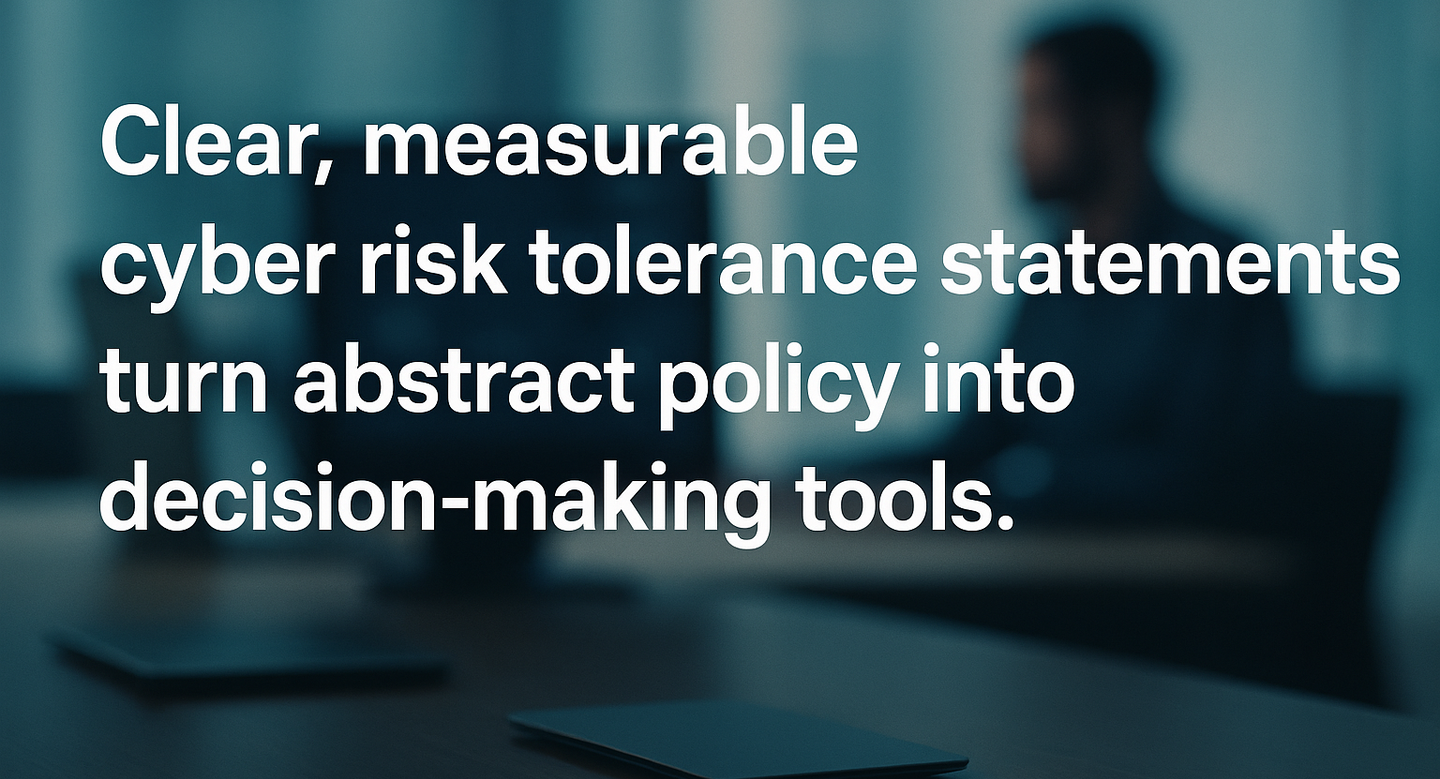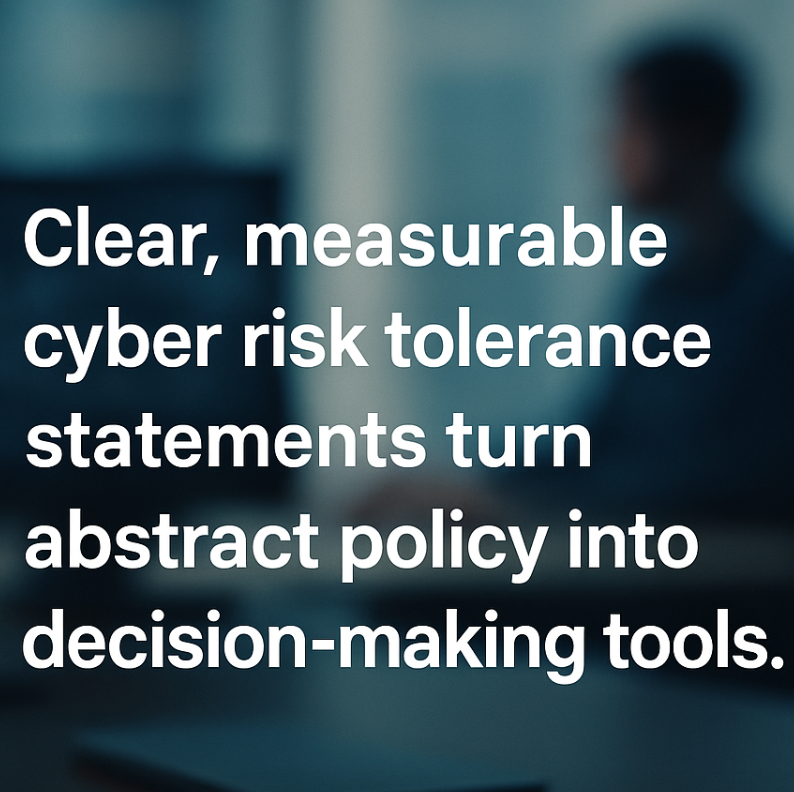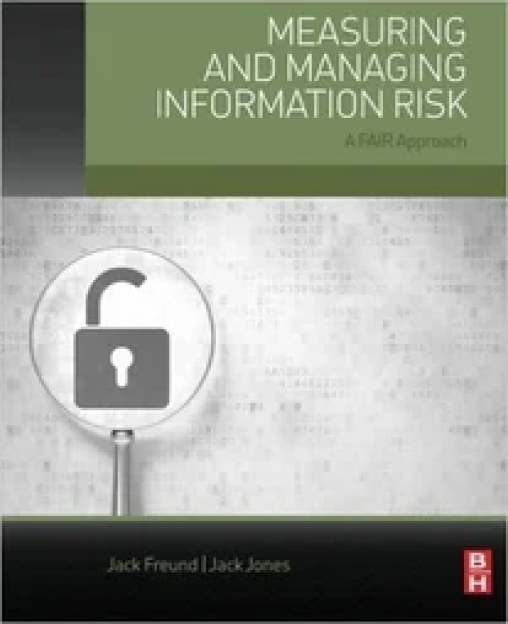

In today’s world, cyber-attacks are inevitable. Cyber risk tolerance defines the operational boundaries that guide decision-making and incident response. It translates high-level cybersecurity risk appetite into concrete thresholds tied to metrics like vulnerability counts, system downtime, phishing rates, and third-party security performance. Cyber risk tolerance provides clear, measurable boundaries that aligns key stakeholders and teams to efficiently respond to cybersecurity threats with consistency and confidence.
 This blog post is contributed by GuidePoint Security, a FAIR Institute sponsor. Author Will Klotz is Senior Information Security Consultant at GuidePoint Security.
This blog post is contributed by GuidePoint Security, a FAIR Institute sponsor. Author Will Klotz is Senior Information Security Consultant at GuidePoint Security.
What Is a Cyber Risk Tolerance Statement?
Cyber risk tolerance defines how much deviation from secure operating norms your organization can accept before corrective action is triggered. It establishes limits for exposure, whether from known vulnerabilities, unpatched systems, or vendor risks.
Cyber Risk Appetite vs Cyber Risk Tolerance: More than Semantics
Understanding the difference between cyber risk appetite and tolerance is essential. Appetite is strategic—it expresses how much cyber risk the organization is willing to pursue in support of business goals. Tolerance is operational—it outlines how much variation from that ideal state is acceptable before escalation is required.
For example: Risk appetite may be 'We are willing to accept moderate cyber risk to support fast feature delivery.' But risk tolerance would specify, 'We tolerate no more than 3 critical vulnerabilities (CVSS 9+) in production systems at any time, with a maximum remediation window of 5 business days.'
In simple terms: cyber risk appetite is the strategic stance on risk, and cyber risk tolerance is the operational guardrails that keeps the business secure and up and running.
Why Cyber Risk Tolerance Matters
Clear, measurable cyber risk tolerance statements turn abstract policy into practical decision-making tools. They help security teams prioritize threats, avoid confusion, and know when and how to act. When integrated into dashboards, incident response playbooks, and risk registers they drive faster decision-making. They also empower teams to take informed risks while avoiding underreaction or overreaction.
Cyber tolerance helps teams know when to:
- Escalate unresolved vulnerabilities or incidents
Trigger incident response procedures - Assess whether current tolerances are within acceptable limits
- How to Create Cyber Risk Tolerance Statements
Establish cyber risk statements that are contextual, collaborative, and actionable.
Step 1: Start with Cyber Risk Appetite
Develop or review your cybersecurity risk appetite statement. This sets the foundation and ensures your tolerance thresholds align with your organization’s broader strategic goals and risk philosophy.
Step 2: Identify and Tune Key Performance Indicators (KPIs) and Key Risk Indicators (KRIs)
Choose KPIs and KRIs tied to real-world cyber threats and operations. Common metrics include: number of unresolved critical vulnerabilities, phishing simulation click rates, system downtime, Mean Time to Detect (MTTD) and Respond (MTTR), Third-party security scorecard ratings). Take the time to review and tune the metrics to ensure they are achievable, relevant and useful.
Step 3: Define Acceptable Thresholds
Using those metrics, determine what levels are tolerable and what crosses the line. Collaborate with IT, security, and risk leaders to set thresholds that are meaningful and realistic.
Step 4: Build Escalation Triggers
For each threshold, define what happens if it's exceeded—whether that’s alerting the CISO, launching a root cause analysis, or initiating incident response.
Step 5: Monitor and Adapt
Cyber threats change quickly. Make sure risk tolerance levels are revisited regularly and updated based on threat intelligence, incident trends, and organizational changes.
Sample Cyber Risk Tolerance Statements
Great tolerance statements link performance data to clear thresholds and predefined actions. When done well, risk tolerance statements help organizations stay aligned, agile, and accountable. Here are some examples.
- “We tolerate up to 5 critical vulnerabilities per month in production systems, with remediation completed within 10 business days.”
- ”We tolerate a phishing click rate of up to 2% across the workforce per quarter.”
- ”We tolerate zero unauthorized access events to production systems. Any event triggers immediate incident response and executive notification.”
- “We tolerate Tier 1 application downtime of no more than 4 hours per incident. Extended outages require a full RCA and board reporting.”
- “We tolerate vendors lacking SOC 2/ISO 27001 certification only with documented exceptions and annual reassessment.”
Cyber Risk Tolerance Maturity Checklist
Use these yes/no questions to gauge where your organization stands.
- Does your organization's risk culture match its risk statements?
- Have you mapped cyber risk tolerance to your security strategy and risk appetite?
- Have you identified relevant cybersecurity KPIs and KRIs?
- Did you collaborate with cross-functional teams (e.g., third party risk, enterprise risk, compliance, IT)?
- Are thresholds actionable, realistic, measurable, and based on historical or benchmark data?
- Do your statements include clear escalation paths and response expectations?
- Are cyber tolerance metrics integrated into dashboards and governance tools?
- Is there a defined process for reviewing and updating tolerance levels?
- Have your tolerance statements been reviewed by executive leadership or a cybersecurity risk committee?
From Reactive to Risk-Aware
Cyber risk tolerance isn’t about being risk-averse, it’s about being risk-smart. By establishing clear, operational guardrails, organizations can respond to threats faster, align teams on what's acceptable, and make informed critical decisions under pressure.
Ready to take control of your cyber risk exposure? Download this whitepaper to get started.









